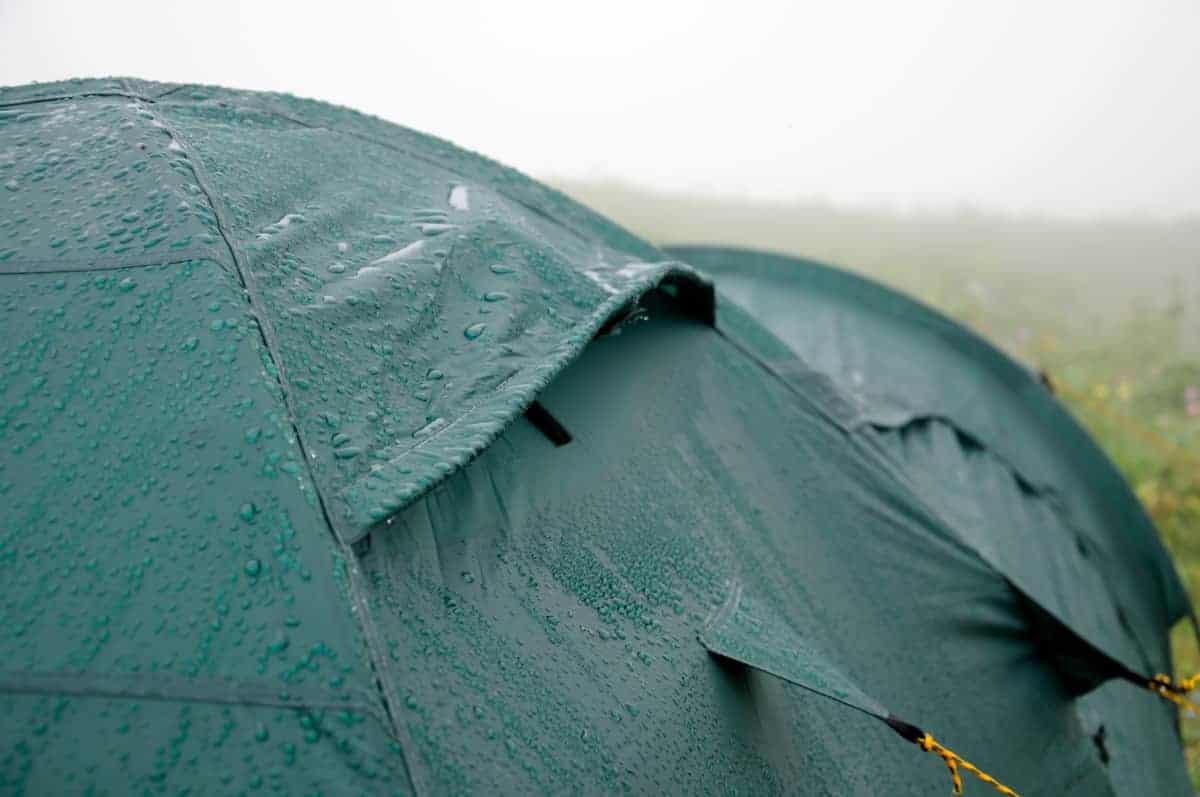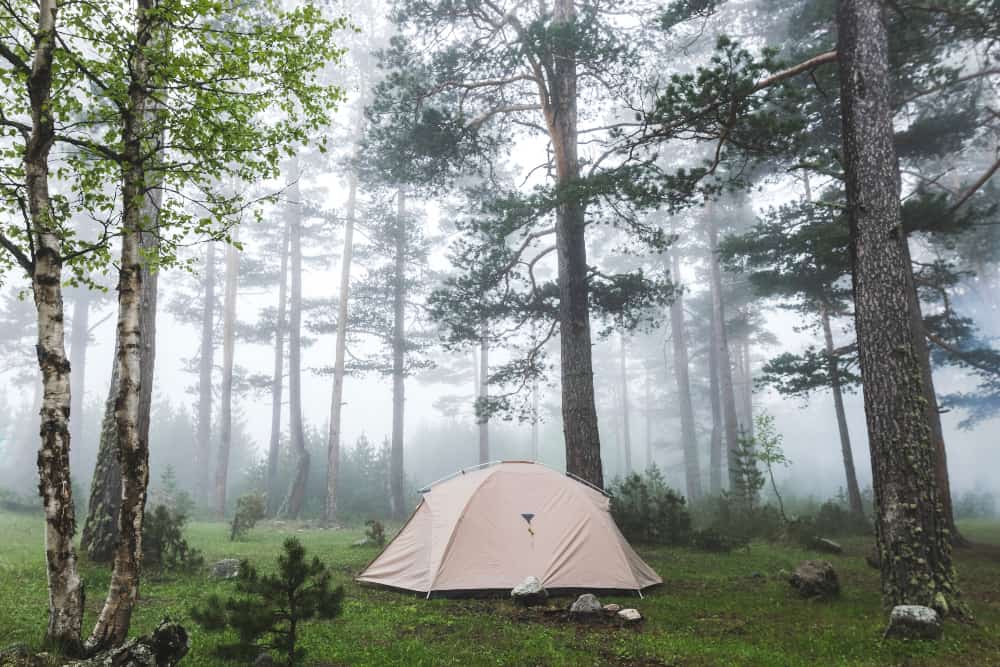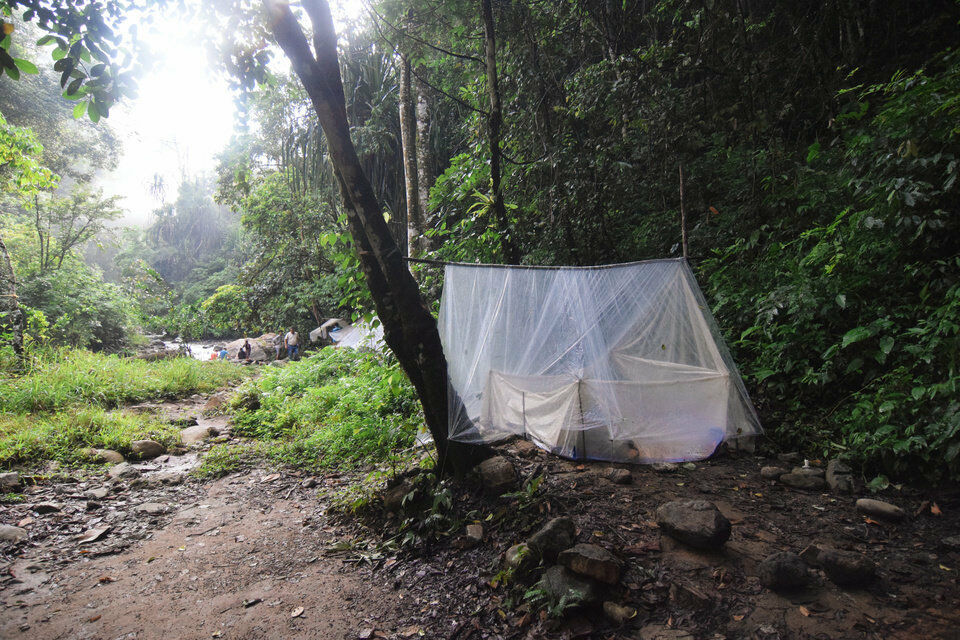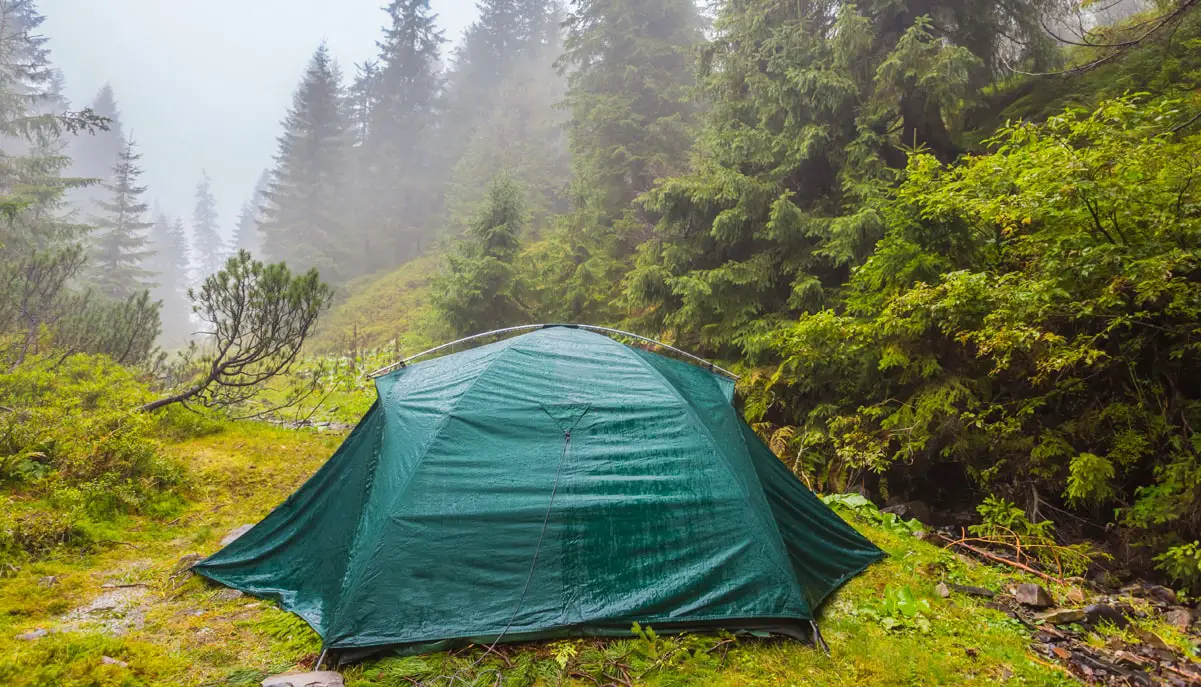On sunny days, we wake up with the sun; on clear nights – a billion stars keep us company. Now, imagine adding the magic of rainfall to the mix. It’s a cozy feeling. But, dampen the tent, or worse, get water seeping in, and that tingling anticipation for an adventurous trip could fast become a soggy nightmare.

That’s where a trusty waterproof tent comes into play – your knight in shining nylon or polyester in battling the forces of nature, keeping you safe and dry, all while you enjoy the beautiful downpour outdoors without care!
But how to spot that perfect waterproof tent? The choices can make things a little muddy. Pun intended! There are loads to consider like waterproof ratings, proper ventilation, durability, and more. But don’t toss your adventurer’s hat love just yet, we’re here to help!
1. The Rainy Day’s Best Friend – Waterproof Ratings
First things first. What are these waterproof ratings we’ve been going on about? Well, have you ever left a paper napkin out in the rain and noticed how quickly it gets soaked? Now if the same thing happens to your tent, you’re in a drippy situation!
The waterproof rating of a tent is like its invincibility cloak. These ratings, measured in millimeters (mm), checked using a fancy technique called Hydrostatic Head Test, tell us how much water the tent can take before feeling overwhelmed. Usually, a tent with a waterproof rating of 1500mm is seen as a good standard, perfect for light showers or drizzles.
But we say, the outdoors is unpredictable, so why not gear up? A rating of 3000mm or even 5000mm guarantees you a snug haven, even when there’s a veritable storm brewing outside. How cool is that?

2. Material Matters
Now that we know how well your tent handles rain, let’s look at the stuff it’s made of. Think of the tent fabric like a good raincoat, it has to keep you dry while staying durable. Usually, waterproof tents are made from polyester or nylon boasting a waterproof polyurethane (PU) or thermoplastic polyurethane (TPU) coating. A good fact to store away in your camper’s mind – nylon and polyester are not naturally waterproof but become so by adding a layer of PU or TPU coating. Now isn’t that a neat trick?
3. Taped Seams – Keeping It Together
Next on our must-check list is ‘taped seams.’ Now, these aren’t exclusive to the latest in fashion but are equally vital to a top-notch waterproof tent. You see, water is wily – it finds sneaky ways to seep in. Taped seams are our best defense here; they keep the stitch lines (places where the fabric has been stitched together) safe from water, with an extra layer of protection. Remember, when it comes to keeping dry, every little detail counts.
4. The Guardian Angel – The Rainfly
Let’s imagine this scenario. You’re all set to step out, and it starts sprinkling. What do you grab? An umbrella, of course! That’s precisely what a rainfly does for your tent. It’s an additional protective layer that sits atop your camping house, guarding it against rain, like a trust, sturdy shield. Rainfly coverage should ideally go up to the ground. So, it’s like a big, protective umbrella for your tent.
5. Not Just A Pretty Shape
The shape of the tent may seem like no biggie — or just a style statement. But let us tell you, it’s pretty strategic. A dome-shaped tent is like a natural slide for water, raining or otherwise, to simply roll off. No water accumulation, no chances of leaks or water seepage. It’s function and style, all rolled into one!
6. Size Does Matter After All!
Let’s steer the conversation to the size and comfort your tent offers. If the weather decides to act tricky, and you’re holed up in your tent for hours, it’s got to be roomy and comfy. Consider the number of people expected in the tent and the amount of gear you’ll bring along. That’s a fair bit of math, but hey, worth it. No one wants a squeezy, crowded space, right?
On average, for two campers a floor area of about 30 square feet is considered comfy. And add 30 for every additional camper in the tent. Do the calculations and choose wisely.

7. A Tent Built to Last
A waterproof tent must be durable — it’s a non-negotiable attribute. A tent has a tough task at hand with all the setup, teardown, storage, and weather battles. So, choose a tent that’s made to last, built with reliable materials, and an excellent build quality. Trust us, you don’t want a flimsy home outdoors.
8. Quick Setup – No Time to Lose
When the weather takes a turn, a tent that’s a pain to set up will feel like a wild goose chase, but without the fun! You need a tent that’s up and ready to shelter in around 15 minutes. So, choosing a tent that’s easy and quick to set, even in challenging weather, is a must!
9. Ventilation – Keeping Things Fresh
Of course, a tent needs to be watertight, but remember, it also needs to breathe. With people and gear inside, condensation can build up quickly and things may get a little ‘icky’. Choose a tent with enough vents, and mesh panels to strike that perfect balance of warmth, comfort, and outdoor freshness.
10. Remember the Groundsheet
Our tent protects us from the rain above, but hey, the chilly, wet ground below needs some taming too. A good quality, waterproof groundsheet is what your tent needs to keep out ground moisture and stay dry, even when it’s a downpour outside.
11. Strong Backbone – The Tent Poles
A tent without its skeleton – the poles, can be a heap of fabric, at best. As we rely on our muscle power to keep us moving, tents need well-built poles for support and balance, especially in windy or rainy weather. Aluminum poles are a preferred choice as they combine strength, flexibility, and a lightweight build.

12. Weight and Portability
A camping trip can be quite the workout, especially if there’s a hike involved. Now, would you fancy lugging a heavy tent around, huffing, and puffing? We thought not! Choose a tent that’s light, and portable, but remember not to compromise on the key features you need – they are non-negotiable.
13. Easy In & Out – Doors and Windows
Whether the rain is playing peek-a-boo or pouring non-stop, getting in and out of your tent shouldn’t feel like an obstacle course. Waterproof zippers, awnings above the doors, and windows to keep the rain out even while they are open for ventilation are not just good-to-haves, but must-haves.
14. A Trial Run
Now that the theory part of it is done, how about some practical? Give the tent a trial run. Set it up, check the interiors, and even spend a couple of hours inside, if not a night. Get a feel of your prospective rain shelter before making it your go-to camping partner.
15. The Price Is Right
While considering all the previous factors, remember that the price is an essential player, too. A quality waterproof tent need not always burn a hole in your pocket. Consider all factors, balance the features with the price you are comfortable with, and make a wise choice. Camping is all about fun on a budget, after all!
16. User Reviews
The tent may look like a million dollars and promise the moon, but a sharp reality check comes from people who’ve used the product. Make sure to pore over user reviews, get the all-round view, including the highs and lows that users faced before putting your money down.
17. Brand Reputation
While you don’t have to stick to brand names only, considering products from brands with a good track record and customer service can save you plenty of headaches in the long run.

18. Extra Features – Sweetening The Deal
When it comes to tents, it’s not always all work and no play. Extra features such as gear loft for added storage, LED light hooks for illumination, power cord vent for that heavenly charger access, can up your camping game by a whole lot.
19. Warranty or Guarantee – The Safety Net
Picking a waterproof tent with a warranty is like betting on a horse that’s favored to win the race – it’s a safe, wise choice. With a warranty, not only do you get a safety net for your purchase, but it’s also a positive indication of the manufacturer’s confidence in their product. It’s a win-win!
20. Personality Peep
While practicality plays its part, don’t let it steal the whole show! Consider the design, color, style, and your personal preferences, too. This trip is all about you, after all!
Frequently Asked Questions
1. What is the ideal waterproof rating for a tent to handle heavy rain?
While a waterproof rating of 1500mm is often considered standard for light rain protection, tents with a rating of 3000mm or higher are recommended if you plan on camping in heavy rain or storms. This elevated rating ensures your tent can withstand more intense rain and keep you dry throughout unexpected weather changes.
2. Are polyester or nylon tents more suitable for rainy camping trips?
Both polyester and nylon tents can provide excellent protection from rain. However, their inherent waterproof capability comes from the polyurethane (PU) or thermoplastic polyurethane (TPU) coating applied to the fabric, rather than the fabric types themselves. Therefore, comparing their waterproof ratings, construction quality, and seam sealing is more important than fabric types when choosing between polyester and nylon tents.
3. How do I protect my tent from ground moisture during heavy rain?
Invest in a good quality, waterproof groundsheet to provide protection from ground moisture and keep your tent dry from the ground up. A groundsheet acts as a barrier between the wet ground and your tent floor, preventing seeping water or dampness within the tent.
4. What kind of tent poles should I look for when choosing a waterproof tent?
Aluminum poles are a popular choice for waterproof tents because of their unique combination of strength, flexibility, and lightness. These qualities make them suitable for withstanding harsh weather conditions while remaining easily portable.
5. Should I always choose a waterproof tent with a warranty?
Opting for a waterproof tent with a warranty is a wise decision as it offers a safety net for your purchase and reflects the manufacturer’s confidence in the product. Also, a reputable brand with good aftersales support is more likely to deliver on its warranty promises and make it easier for you to access assistance if required.
Final Verdict
And there you have it, the 20 essential things you need to consider while buying the best waterproof tent for camping in the rain. It’s like a super satisfying dish – all the ingredients coming together to create an awesome experience! By paying attention to these key factors, you’re bound to find the perfect tent that keeps you dry, cozy, and happy, even when the rain comes pouring down! With these tips handy, go forth, and may the forces of nature always be in your favor, always. Happy camping!
